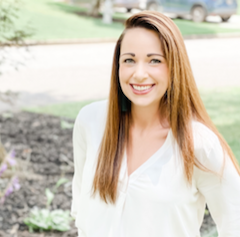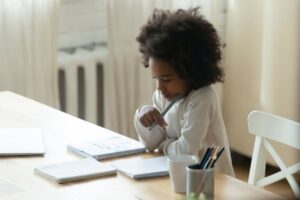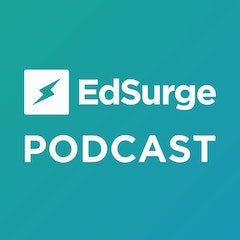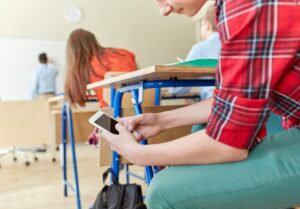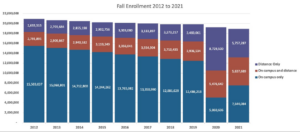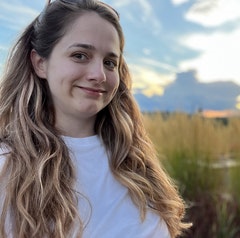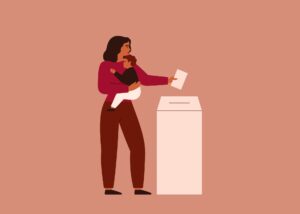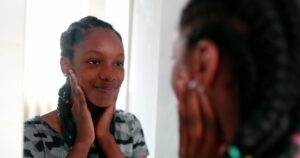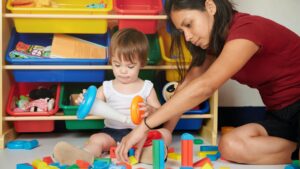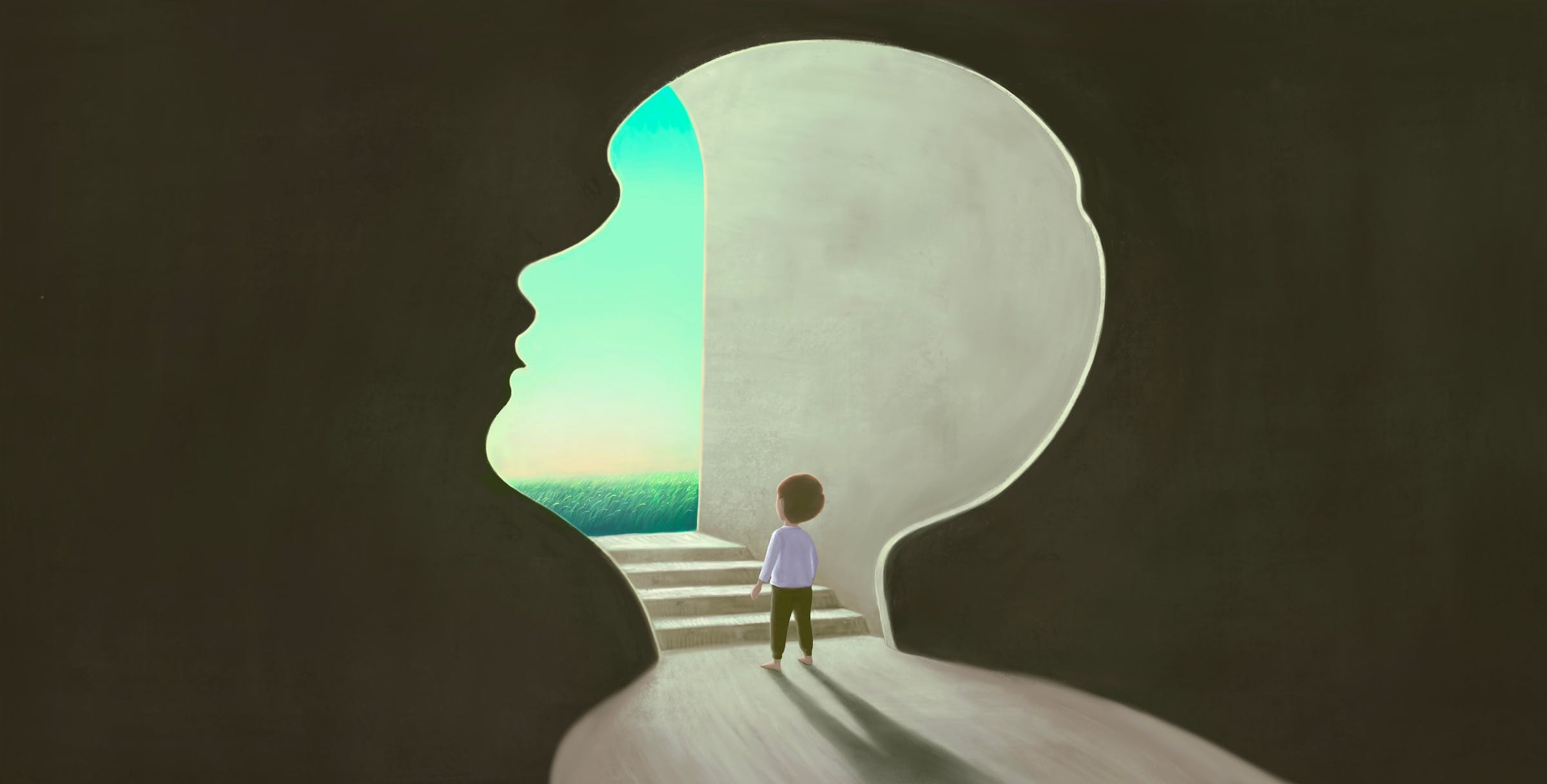
What have we been conditioned to think an effective classroom looks like? For many, it’s a vision that includes tables of students sitting quietly, working diligently as the teacher walks around or pulls small groups. But when I reflect back on my own childhood and on what I’ve learned in my career as a paraprofessional, it’s clear that the most effective classrooms aren’t necessarily the ones that are most quiet or still, but the ones that prioritize relationships and community building.
The COVID-19 pandemic shifted a lot for educators and students. Many existing gaps and disparities became even greater during the height of the crisis and in a push to recover from these losses, many districts, including mine, have implemented new testing and curricular mandates that have put immense pressure on educators. This has left less room to focus on the things we know matter most like relationship-building, social-emotional development and building a respectful, inclusive classroom community. It’s been difficult to find a balance between centering community development and meeting these demands.
Serving as a paraprofessional for eight years, I have had the unique experience of being in multiple classrooms. I’ve seen how different teachers build classroom communities and the ones that have been most successful have focused on creating lively spaces where children and staff are allowed to be themselves.
Although every classroom is unique, one common thread I’ve found is a focus on relationships, but that takes time and capacity, which has become more strained over the past few years.
New Mandates Pull Focus From What Matters Most
The most effective teachers I’ve worked with spend a lot of one-on-one time with students, whether to support them through a lesson, bond with them over a shared interest like the latest video game to come out, or learn more about them, for example, by hearing how a recent family outing went. They also spend time getting to know their colleagues. For me, that part is important because I collaborate best when I feel like I can relate to the people I work with beyond the work we do together.
One telltale sign of a classroom community built upon strong relationships is when a teacher can put an academic lesson aside in order to address events happening inside the classroom that might be impacting the social-emotional development of learners.
For example, I remember an instance when we were working on a lesson, but some of our students were fixated on a situation that occurred during recess. A basketball game got too serious and the word “bullying” was being thrown around. I recall that we were able to take the time to sit down and talk about it. We paused everything else to define bullying, discuss what our students could do — as individuals and as a collective — to intervene or call out instances of bullying, and talk about how to build a community of individuals that look out for one another.
I remember thinking to myself how I admired the teacher for recognizing that it was imperative for our students to feel like that conversation was prioritized. They wouldn’t have been able to focus on anything else. When we picked that lesson back up the next day, they were attentive and participation was higher than usual. There are many moments like that which arise throughout the year. Staying on our toes and figuring out which ones to address with a whole group discussion versus which to address in a small group or with an individual is part of the job.
I have also witnessed how crucial it is to be able to take a step back and say “let’s pause on our work” to a student who is having a behavioral challenge in the classroom, and to take the time to actually get to the bottom of what feelings they’re having and where the behavior is coming from. To do my job well, I need to be able to step away from the work sometimes — to have space to just talk and connect with the student I’m supporting. When I am able to connect with a student and understand what is causing a certain behavior, I can better support them. And most of the time, I’ve found that moments outside of school, maybe something that happened at home the night before or on their way to school earlier in the morning, are contributing to student behavior in class.
Being able to put a lesson aside to bond with a student or have a conversation about something nonacademic that is impacting the class is so important. But the freedom to do that is slipping away.
In my district, pandemic recovery has prompted a number of transitions, which require a great amount of focus and momentum. The start of this school year brought with it a list of new mandates, including a literacy curriculum overhaul and a number of new reading and math assessments to administer to students in the first three months. And in September, administrators at our school created a suggested pacing calendar to give us a sense of where we should be for each subject throughout the year. It was packed and left no buffer days between September and June.
My time is limited as it is and I feel like I’m being pulled in twenty different directions all the time. Plugging new curriculum and assessments into our already busy schedules has created a stressful, rigid environment, which, I’m afraid, may cause harm to our students as they continue their educational careers.
In my school, these shifts have brought increased stress, decreased opportunities to pivot when our students need, and have led to a departure from social-emotional learning, which has changed the way our classrooms look and feel. One question I keep asking myself is how much this shift will cost our students and staff in the long run?
In Effective Classrooms, Relationships Are a Priority
There isn't one approach to an effective classroom. I’ve seen a number of them and they’ve all had a different vibe. But one thing I know for sure is that relationships come first. Those of us working directly with students have a responsibility to push back when certain mandates aren't beneficial. When education becomes too heavily focused on testing and data gathering, we begin to lose bandwidth to get to know our students more deeply and flexibility to change gears when we need to.
Before the pandemic, my school created nurturing learning environments where students and staff could be themselves. Now, we're all so concerned with the multitudes of deadlines, rapidly changing requirements and new mandates that we've lost our way.
It is only November, but I am already at a March level of exhaustion. It’s time to reflect on how these changes are shaping teaching and learning experiences. Yes, we need solutions that address the losses we’re facing, but not ones that add to our already overflowing workload or that pull time away from getting to know our students and building relationships with them.
- SEO Powered Content & PR Distribution. Get Amplified Today.
- PlatoData.Network Vertical Generative Ai. Empower Yourself. Access Here.
- PlatoAiStream. Web3 Intelligence. Knowledge Amplified. Access Here.
- PlatoESG. Carbon, CleanTech, Energy, Environment, Solar, Waste Management. Access Here.
- PlatoHealth. Biotech and Clinical Trials Intelligence. Access Here.
- Source: https://www.edsurge.com/news/2023-12-15-as-a-paraprofessional-working-in-the-classroom-i-ve-learned-that-relationships-come-first
- :has
- :is
- :not
- :where
- $UP
- a
- Able
- About
- about IT
- academic
- actually
- add
- address
- administer
- administrators
- afraid
- All
- allowed
- already
- also
- am
- amount
- an
- and
- Another
- anything
- approach
- ARE
- arise
- around
- AS
- aside
- asking
- assessments
- At
- away
- back
- Balance
- Bandwidth
- Basketball
- BE
- became
- because
- become
- becomes
- been
- before
- begin
- behavior
- being
- beneficial
- BEST
- Better
- between
- Beyond
- bond
- Bottom
- brought
- buffer
- build
- Building
- built
- bullying
- busy
- but
- by
- Calendar
- call
- CAN
- Capacity
- Career
- careers
- Cause
- causing
- centering
- certain
- challenge
- change
- changed
- Changes
- changing
- Children
- class
- classroom
- clear
- collaborate
- colleagues
- Collective
- come
- coming
- Common
- Communities
- community
- Community Development
- concerned
- Connect
- continue
- contributing
- Conversation
- Cost
- could
- COVID-19
- COVID-19 pandemic
- created
- Creating
- crisis
- crucial
- Curriculum
- data
- day
- Days
- decreased
- define
- demands
- departure
- Development
- different
- difficult
- diligently
- directions
- directly
- discuss
- discussion
- district
- do
- down
- during
- each
- Earlier
- Education
- educational
- educators
- Effective
- else
- Environment
- environments
- Ether (ETH)
- Even
- events
- Every
- everything
- example
- existing
- experience
- Experiences
- facing
- family
- feel
- feelings
- few
- Find
- First
- Flexibility
- Focus
- focused
- For
- found
- Freedom
- from
- game
- gaps
- gathering
- gears
- get
- getting
- Give
- got
- great
- greater
- Group
- Group’s
- had
- happened
- Happening
- harm
- Have
- having
- hearing
- heavily
- height
- higher
- Home
- How
- How To
- HTML
- HTTPS
- i
- immense
- impacting
- imperative
- implemented
- important
- in
- includes
- Including
- Inclusive
- increased
- individual
- individuals
- inside
- instance
- instances
- interest
- intervene
- into
- isn
- IT
- Job
- jpg
- june
- just
- Keep
- Know
- latest
- LEARN
- learned
- learners
- learning
- Led
- left
- less
- lesson
- Level
- like
- Limited
- List
- Long
- Look
- LOOKS
- lose
- losses
- lost
- Lot
- mandates
- many
- March
- math
- Matter
- Matters
- May..
- maybe
- me
- meeting
- might
- mine
- Moments
- Momentum
- months
- more
- morning
- most
- much
- multiple
- multitudes
- my
- myself
- necessarily
- Need
- New
- news
- next
- night
- no
- November
- now
- number
- nurturing
- NYC
- occurred
- of
- on
- ONE
- ones
- only
- opportunities
- or
- order
- our
- out
- outside
- over
- own
- packed
- pandemic
- part
- participation
- past
- pause
- paused
- People
- picked
- Pivot
- plato
- Plato Data Intelligence
- PlatoData
- pressure
- Prioritize
- prioritized
- Pulls
- Push
- push back
- put
- question
- quietly
- rapidly
- RE
- Reading
- recent
- recognizing
- Recover
- recovery
- reflect
- Relationships
- remember
- require
- Requirements
- responsibility
- rigid
- Room
- Run
- say
- School
- Schools
- seen
- sense
- September
- serious
- shaping
- shared
- shift
- shifted
- Shifts
- should
- sign
- sit
- Sitting
- situation
- slipping
- small
- So
- Solutions
- some
- something
- sometimes
- Space
- spaces
- spend
- Staff
- start
- staying
- Step
- Still
- stress
- strong
- Student
- Students
- subject
- successful
- support
- Supporting
- sure
- T
- Take
- takes
- Talk
- teacher
- teachers
- Teaching
- Testing
- than
- that
- The
- their
- Them
- themselves
- There.
- These
- they
- thing
- things
- think
- Thinking
- this
- those
- three
- Through
- throughout
- time
- to
- together
- too
- transitions
- twenty
- understand
- unique
- upon
- us
- usual
- Ve
- Versus
- Vibe
- Video
- video game
- vision
- walks
- was
- Way..
- we
- WELL
- went
- were
- What
- What is
- when
- whether
- which
- WHO
- whole
- will
- with
- witnessed
- Word
- Work
- worked
- working
- year
- years
- yes
- zephyrnet

